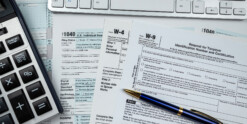A Wild Ride Results in a Negative First Quarter
The first quarter began as 2017 ended: a steady ascent higher with limited volatility. January posted a 7.5% gain as the effects of corporate tax reform began to emerge in earnings estimates for 2018 and beyond. Unfortunately, the trend did not last. Starting in late January and into early February, the S&P 500 officially entered correction territory by declining more than 10%. Afterwards, we’ve seen large daily gyrations both positive and negative, resulting in a first quarter down about 1%. We spoke often last year regarding our belief that record low levels of volatility could not persist forever. And while the spike in volatility was not unexpected, it’s never easy to watch the Dow fall over 1,000 points in a single day as it did on February 5th. But, taking a longer term view it appears to us tailwinds remain for global equity markets during 2018.
The New Worry Of The Day: Tariffs
In today’s world investors like to assign a “reason” for every market move. The most recent explanation for choppy markets resides in the possibility of a trade war with China. For some context, we’d like to point out the initial decline in equity markets stemmed not from trade wars and tariffs, but from inflation fears sparked by a 2.9% gain in hourly wages. Following a downward revision plus a few more months of data, little is said these days on this front. So, the narrative for market calamity has now shifted to a trade war between the US and China. We understand the situation is fluid and agree that an all-out trade war between the US and China would be a clear negative for risk assets around the world. But, we’re a long way from that. We will keep a close eye on future developments, but for now, let’s discuss what has been proposed. There have been approximately $82 billion of potential tariffs announced thus far. This is not an insignificant amount, but let’s put this in context. Tax cuts passed late last year are estimated to add $200 billion back to the economy, while repatriation of foreign cash is estimated to add $500 billion and infrastructure spending another $100 billion. So, for now, the tariff impact is dwarfed by fiscal stimulus. We believe tariff fears are overblown while the fiscal stimulus is largely being overlooked.
The US Economy Remains Resilient
At the risk of sounding like a broken record, we continue to find little wrong with the US economy. We have now been in an economic expansion for 105 months, or the third longest on record. There’s reason to believe we could set a record by extending into next summer. Despite its lengthy nature, the current expansion has been shallow in terms of real GDP growth. In fact, to reach the level of growth seen during the 1990s record, the US would need to grow real GDP another 25%. And here we are hoping to return to just 3% annual growth! We continue to monitor all facets of the US economy, and at the moment all is well. Consumer confidence sits at all-time highs, wage growth is steadily improving and the unemployment rate at 4.1% sits well below the historical average of 6.2%. We acknowledge our government’s responsibility to address the deficits in part caused by the tax cuts, but for now they should act as another tailwind during 2018.
Fundamentals Remain Encouraging Despite Market Choppiness
The first quarter was unnerving. There’s no other way to put it. Even the most seasoned investors can get rattled by violent moves to the downside. But, we find comfort in stepping back and asking ourselves: what has changed? And the reality is little changed from late January to early February when the market moved into correction territory. The economy continues to chug along, while headline grabbing trade war threats are (for the moment) dwarfed in size by fiscal stimulus heading our way during 2018. We also would like to point out the less talked about silver lining produced by corrections. Equity valuations and investor sentiment have become much more favorable. The S&P forward multiple (valuation) now sits roughly in-line with its long-term average after being elevated for much of the past year. Investor sentiment, which we described as complacent late last year, can now best be described as pessimistic, a historically bullish sign.
In sum, despite our expectation for choppy markets to persist particularly as mid-term elections heat up, we remain positive on global equities. At the same time, we believe caution is warranted in the global bond market due to building interest rate pressure as global central banks become less accommodative. It’s worth reiterating that every investing environment comes with worries as well as opportunities. Our belief is that a well-constructed diversified portfolio of stocks and bonds will withstand any investing climate over time.
Please reach out with any comments or questions you may have.
Regards,
The Investment Committee













